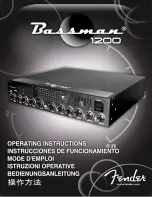
4
Overview
SySteM coMponentS
The m802 system consists of an 8 channel preamplifier chassis, a power supply chassis, and an optional remote
control unit (referred to as the RCU in the rest of this manual). The preamplifier chassis contains 8 audio ampli-
fier PCBs, a micro controller PCB, and a front panel control interface. For remote control communications, the
preamplifier chassis is equipped with two D-sub 9 pin connectors which carry Philips
I
2
C
and RS-485 / RS-422
signals, as well as MIDI IN and OUT connectors. The use of an external DC power supply unit ensures that no
power line interference can compromise the performance of the sensitive microphone amplifier circuits.
As well as the standard 48V phantom powered microphone inputs, the m802 can be ordered with optional 130V
inputs for use with the DPA (formerly B&K) high voltage microphones. These microphones employ a high volt-
age transformerless impedance conversion circuit, which is not subject to the limitations of the 48V phantom
powering standard. However, being unbalanced, the DPA 130V microphones benefit greatly from short cable
runs from microphone to preamplifier.
Additionally, an optional extremely high performance 8-channel analog-to-digital converter module is avail-
able for the m802. This converter module supports sample rates up to 192kHz at 24bit resolution.
The RCU features an expanded version of the preamplifier front panel interface and has a single I
2
C / RS-485 /
RS-422 bus connector as well as a DC power Jack.
reMote control optionS
The m802 preamplifier can be controlled by the RCU, via MIDI, or directly from its front panel. The RCU connects
to the preamplifier via an
I
2
C
, RS-485 or RS-422 signal, which makes a parallel connection between all of the
devices in the system. In an m802 system, the RCU is the master and all of the preamplifiers are slaves. The data
on the display of the RCU is echoed back from the preamplifier so it shows the actual status of the preamplifier.
For example, when you tell a preamplifier to change its gain at the RCU, the RCU will send the gain change com-
mand to the preamplifier and then ask the preamplifier what its current gain setting is. The RCU will then update
its own display to reflect the change. This gives the user absolute confidence that what is visible on the display is
exactly what is happening at the preamplifier. If the RCU is disconnected from the preamplifier(s), the data fields
in the display will go blank, but the preamplifiers will continue to operate normally.
The RCU can control up to 8 preamplifiers (64 channels) by connecting it to one preamplifier and then connect-
ing the remaining preamplifiers together with I
2
C / RS-485 / RS-422 cables in a daisy chain fashion. In I
2
C mode,
control signal can be sent up to 1000 feet, in RS-485 / RS-422 over 3000 feet. Using the adapters included with
the RCU, standard microphone cable can be used for this interface (except for RS-422 connections). Only one
RCU can be connected to a system at any time.
The m802 can also be controlled via MIDI. When the m802 sees any activity on its MIDI input port, it automati-
cally switches into MIDI control mode. In this mode, the m802 will emulate a AVID PRE microphone preamplifier.
After a period of 16 seconds with no activity on the MIDI input port, the m802 will automatically revert back to
its normal control mode. See the MIDI Control section of this manual for more details on the MIDI control mode.





































